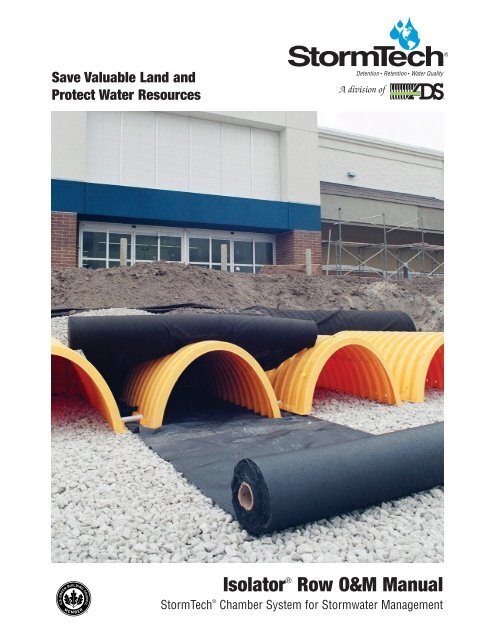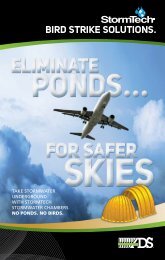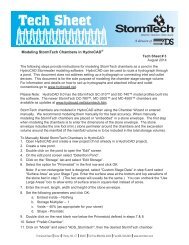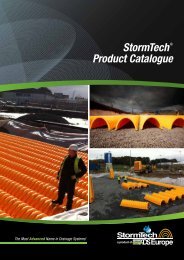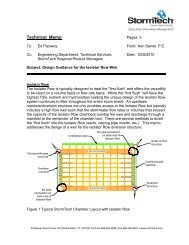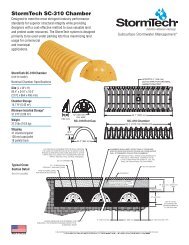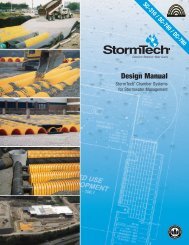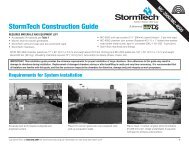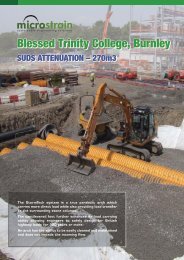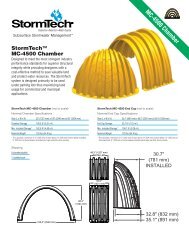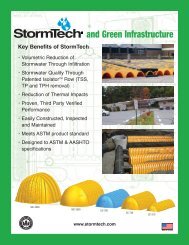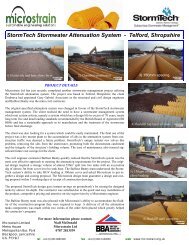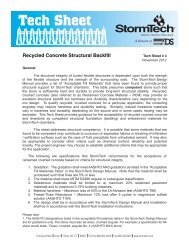Isolator Row⢠O&M Manual - StormTech
Isolator Row⢠O&M Manual - StormTech
Isolator Row⢠O&M Manual - StormTech
Create successful ePaper yourself
Turn your PDF publications into a flip-book with our unique Google optimized e-Paper software.
Save Valuable Land and<br />
Protect Water Resources<br />
Detention • Retention • Water Quality<br />
A division of<br />
<strong>Isolator</strong> ® Row O&M <strong>Manual</strong><br />
<strong>StormTech</strong> ® Chamber System for Stormwater Management
1.0 The <strong>Isolator</strong> ® Row<br />
1.1 INTRODUCTION<br />
An important component of any Stormwater Pollution<br />
Prevention Plan is inspection and maintenance. The<br />
<strong>StormTech</strong> <strong>Isolator</strong> Row is a patented technique to<br />
inexpensively enhance Total Suspended Solids (TSS)<br />
removal and provide easy access for inspection and<br />
maintenance.<br />
The <strong>Isolator</strong> Row is typically designed to capture the<br />
“first flush” and offers the versatility to be sized on a volume<br />
basis or flow rate basis. An upstream manhole not<br />
only provides access to the <strong>Isolator</strong> Row but typically<br />
includes a high flow weir such that storm water flowrates<br />
or volumes that exceed the capacity of the <strong>Isolator</strong> Row<br />
overtop the over flow weir and discharge through a<br />
manifold to the other chambers.<br />
The <strong>Isolator</strong> Row may also be part of a treatment train.<br />
By treating storm water prior to entry into the chamber<br />
system, the service life can be extended and pollutants<br />
such as hydrocarbons can be captured. Pre-treatment<br />
best management practices can be as simple as deep<br />
sump catch basins, oil-water separators or can be innovative<br />
storm water treatment devices. The design of<br />
the treatment train and selection of pretreatment devices<br />
by the design engineer is often driven by regulatory<br />
requirements. Whether pretreatment is used or not, the<br />
<strong>Isolator</strong> Row is recommended by <strong>StormTech</strong> as an<br />
effective means to minimize maintenance requirements<br />
and maintenance costs.<br />
Looking down the <strong>Isolator</strong> Row from the manhole opening, woven<br />
geotextile is shown between the chamber and stone base.<br />
1.2 THE ISOLATOR ROW<br />
The <strong>Isolator</strong> Row is a row of <strong>StormTech</strong> chambers, either<br />
SC-310, SC-310-3, SC-740, DC-780, MC-3500 or MC-<br />
4500 models, that is surrounded with filter fabric and connected<br />
to a closely located manhole for easy access. The<br />
fabric-wrapped chambers pro vide for settling and filtration<br />
of sediment as storm water rises in the <strong>Isolator</strong> Row<br />
and ultimately passes through the filter fabric. The open<br />
bottom chambers and perforated sidewalls (SC-310, SC-<br />
310-3 and SC-740 models) allow storm water to flow both<br />
vertically and horizon tally out of the chambers.<br />
Sediments are cap tured in the <strong>Isolator</strong> Row protecting<br />
the storage areas of the adjacent stone and chambers<br />
from sediment accumulation.<br />
Note: See the <strong>StormTech</strong> Design <strong>Manual</strong> for detailed<br />
information on designing inlets for a <strong>StormTech</strong> system,<br />
including the <strong>Isolator</strong> Row.<br />
<strong>StormTech</strong> <strong>Isolator</strong> Row with Overflow Spillway<br />
(not to scale)<br />
MANHOLE<br />
WITH<br />
OVERFLOW<br />
WEIR<br />
OPTIONAL<br />
PRE-TREATMENT<br />
STORMTECH<br />
ISOLATOR ROW<br />
Two different fabrics are used for the <strong>Isolator</strong> Row. A<br />
woven geotextile fabric is placed between the stone<br />
and the <strong>Isolator</strong> Row chambers. The tough geo textile<br />
provides a media for storm water filtration and provides<br />
a durable surface for maintenance operations. It is also<br />
designed to prevent scour of the underlying stone and<br />
remain intact during high pressure jetting. A non-woven<br />
fabric is placed over the chambers to provide a filter<br />
media for flows passing through the perforations in the<br />
sidewall of the chamber. The non-woven fabric is not<br />
required over the DC-780, MC-3500 or MC-4500 models<br />
as these chambers do not have perforated side walls.<br />
ECCENTRIC<br />
HEADER<br />
OPTIONAL<br />
ACCESS<br />
STORMTECH CHAMBERS<br />
2 Call <strong>StormTech</strong> at 888.892.2694 or visit our website at www.stormtech.com for technical and product information.
2.0 <strong>Isolator</strong> Row Inspection/Maintenance<br />
2.1 INSPECTION<br />
The frequency of Inspection and Maintenance varies<br />
by location. A routine inspection schedule needs to be<br />
established for each individual location based upon site<br />
specific variables. The type of land use (i.e. industrial,<br />
commercial, residential), anticipated pollutant load, percent<br />
imperviousness, climate, etc. all play a critical role<br />
in determining the actual frequency of inspection and<br />
maintenance practices.<br />
At a minimum, <strong>StormTech</strong> recommends annual inspections.<br />
Initially, the <strong>Isolator</strong> Row should be inspected every<br />
6 months for the first year of operation. For sub sequent<br />
years, the inspection should be adjusted based upon<br />
previous observation of sediment deposition.<br />
The <strong>Isolator</strong> Row incorporates a combination of standard<br />
manhole(s) and strategically located inspection ports<br />
(as needed). The inspection ports allow for easy access<br />
to the system from the surface, eliminating the need to<br />
perform a confined space entry for inspection purposes.<br />
If upon visual inspection it is found that sediment has<br />
accumulated, a stadia rod should be inserted to determine<br />
the depth of sediment. When the average depth<br />
of sediment exceeds 3 inches throughout the length of<br />
the <strong>Isolator</strong> Row, clean-out should be performed.<br />
2.2 MAINTENANCE<br />
The <strong>Isolator</strong> Row was designed to reduce the cost of<br />
periodic maintenance. By “isolating” sediments to just<br />
one row, costs are dramatically reduced by eliminating<br />
the need to clean out each row of the entire storage<br />
bed. If inspection indicates the potential need for maintenance,<br />
access is provided via a manhole(s) located<br />
on the end(s) of the row for cleanout. If entry into the<br />
manhole is required, please follow local and OSHA rules<br />
for a confined space entries.<br />
Examples of culvert cleaning nozzles appropriate for <strong>Isolator</strong> Row<br />
maintenance. (These are not <strong>StormTech</strong> products.)<br />
Maintenance is accomplished with the JetVac process.<br />
The JetVac process utilizes a high pressure water nozzle<br />
to propel itself down the <strong>Isolator</strong> Row while scouring<br />
and suspending sediments. As the nozzle is retrieved,<br />
the captured pollutants are flushed back into the manhole<br />
for vacuuming. Most sewer and pipe maintenance<br />
companies have vacuum/JetVac combination vehicles.<br />
Selection of an appropriate JetVac nozzle will improve<br />
maintenance efficiency. Fixed nozzles designed for culverts<br />
or large diameter pipe cleaning are preferable.<br />
Rear facing jets with an effective spread of at least 45”<br />
are best. Most JetVac reels have 400 feet of hose allowing<br />
maintenance of an <strong>Isolator</strong> Row up to 50 chambers<br />
long. The JetVac process shall only be performed on<br />
<strong>StormTech</strong> <strong>Isolator</strong> Rows that have AASHTO class 1<br />
woven geotextile (as specified by <strong>StormTech</strong>) over<br />
their angular base stone.<br />
<strong>StormTech</strong> <strong>Isolator</strong> Row (not to scale)<br />
NOTE: NON-WOVEN FABRIC IS ONLY REQUIRED OVER THE INLET PIPE CONNECTION INTO THE END CAP FOR DC-780, MC-3500 AND<br />
MC-4500 CHAMBER MODELS AND IS NOT REQUIRED OVER THE ENTIRE ISOLATOR ROW.<br />
Call <strong>StormTech</strong> at 888.892.2694 or visit our website at www.stormtech.com for technical and product information. 3
3.0 <strong>Isolator</strong> Row Step By Step Maintenance Procedures<br />
Step 1) Inspect <strong>Isolator</strong> Row for sediment<br />
A) Inspection ports (if present)<br />
i. Remove lid from floor box frame<br />
ii. Remove cap from inspection riser<br />
iii. Using a flashlight and stadia rod,<br />
measure depth of sediment and<br />
record results on maintenance log.<br />
iv. If sediment is at, or above, 3 inch<br />
depth proceed to Step 2. If not<br />
proceed to step 3.<br />
B) All <strong>Isolator</strong> Rows<br />
i. Remove cover from manhole at<br />
upstream end of <strong>Isolator</strong> Row<br />
ii.<br />
<strong>StormTech</strong> <strong>Isolator</strong> Row (not to scale)<br />
1) B) 1) A)<br />
2<br />
Using a flashlight, inspect down <strong>Isolator</strong> Row through outlet pipe<br />
1. Mirrors on poles or cameras may be used to avoid a confined space entry<br />
2. Follow OSHA regulations for confined space entry if entering manhole<br />
iii. If sediment is at or above the lower row of sidewall holes (approximately 3 inches) proceed to Step 2.<br />
If not proceed to Step 3.<br />
Step 2) Clean out <strong>Isolator</strong> Row using the JetVac process<br />
A) A fixed culvert cleaning nozzle with rear facing nozzle spread of 45 inches or more is preferable<br />
B) Apply multiple passes of JetVac until backflush water is clean<br />
C) Vacuum manhole sump as required<br />
Step 3) Replace all caps, lids and covers, record observations and actions<br />
Step 4) Inspect & clean catch basins and manholes upstream of the <strong>StormTech</strong> system<br />
4<br />
Sample Maintenance Log<br />
Stadia Rod Readings<br />
Fixed point Fixed point<br />
Date<br />
to chamber to top of<br />
bottom (1) sediment (2)<br />
Sediment<br />
Depth Observations/Actions Inspector<br />
(1) - (2)<br />
3/15/01 6.3 ft. none New installation. Fixed point is Cl frame at grade djm<br />
9/24/01 6.2 0.1 ft. Some grit felt sm<br />
6/20/03 5.8 0.5 ft. Mucky feel, debris visible in manhole and in rv<br />
<strong>Isolator</strong> row, maintenance due<br />
7/7/03 6.3 ft. 0 System jetted and vacuumed djm<br />
Detention • Retention • Water Quality<br />
A division of<br />
70 Inwood Road, Suite 3 Rocky Hill Connecticut 06067<br />
860.529.8188 888.892.2694 fax 866.328.8401 www.stormtech.com<br />
ADS “Terms and Conditions of Sale” are available on the ADS website, www.ads-pipe.com<br />
Advanced Drainage Systems, the ADS logo, and the green stripe are registered trademarks of Advanced Drainage Systems.<br />
Stormtech ® and the <strong>Isolator</strong> ® Row are registered trademarks of <strong>StormTech</strong>, Inc.<br />
Green Building Council Member logo is a registered trademark of the U.S. Green Building Council.<br />
© 2013 Advanced Drainage Systems, Inc. SO90809 02/13


